
Waterspout
Encyclopedia
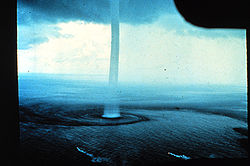
Vortex
A vortex is a spinning, often turbulent,flow of fluid. Any spiral motion with closed streamlines is vortex flow. The motion of the fluid swirling rapidly around a center is called a vortex...
(usually appearing as a funnel
Funnel
A funnel is a pipe with a wide, often conical mouth and a narrow stem. It is used to channel liquid or fine-grained substances into containers with a small opening. Without a funnel, spillage would occur....
-shaped cloud
Cloud
A cloud is a visible mass of liquid droplets or frozen crystals made of water and/or various chemicals suspended in the atmosphere above the surface of a planetary body. They are also known as aerosols. Clouds in Earth's atmosphere are studied in the cloud physics branch of meteorology...
) that occurs over a body of water
Body of water
A body of water or waterbody is any significant accumulation of water, usually covering the Earth or another planet. The term body of water most often refers to large accumulations of water, such as oceans, seas, and lakes, but it may also include smaller pools of water such as ponds, puddles or...
and is connected to a cumuliform cloud. In the common form, it is a non-supercell
Supercell
A supercell is a thunderstorm that is characterized by the presence of a mesocyclone: a deep, continuously-rotating updraft. For this reason, these storms are sometimes referred to as rotating thunderstorms...
tornado
Tornado
A tornado is a violent, dangerous, rotating column of air that is in contact with both the surface of the earth and a cumulonimbus cloud or, in rare cases, the base of a cumulus cloud. They are often referred to as a twister or a cyclone, although the word cyclone is used in meteorology in a wider...
over water. While it is often weaker than most of its land counterparts, stronger versions spawned by mesocyclone
Mesocyclone
A mesocyclone is a vortex of air, approximately 2 to 10 miles in diameter , within a convective storm....
s do occur. Waterspouts do not suck up water; the water seen in the main funnel cloud is actually water droplets formed by condensation. While many waterspouts form in the tropics, locations at higher latitude within temperate zones also report waterspouts, such as Europe
Europe
Europe is, by convention, one of the world's seven continents. Comprising the westernmost peninsula of Eurasia, Europe is generally 'divided' from Asia to its east by the watershed divides of the Ural and Caucasus Mountains, the Ural River, the Caspian and Black Seas, and the waterways connecting...
and the Great Lakes
Great Lakes
The Great Lakes are a collection of freshwater lakes located in northeastern North America, on the Canada – United States border. Consisting of Lakes Superior, Michigan, Huron, Erie, and Ontario, they form the largest group of freshwater lakes on Earth by total surface, coming in second by volume...
. Although rare, waterspouts have been observed in connection with lake-effect snow precipitation bands
Rainband
A rainband is a cloud and precipitation structure associated with an area of rainfall which is significantly elongated. Rainbands can be stratiform or convective, and are generated by differences in temperature. When noted on weather radar imagery, this precipitation elongation is referred to as...
.
Waterspouts have a five-part life cycle: formation of a dark spot on the water surface, spiral pattern on the water surface, formation of a spray ring, development of the visible condensation funnel, and ultimately decay.
Formation
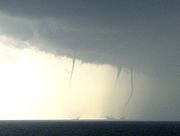
Supercell
A supercell is a thunderstorm that is characterized by the presence of a mesocyclone: a deep, continuously-rotating updraft. For this reason, these storms are sometimes referred to as rotating thunderstorms...
. While some waterspouts are strong and tornadic in nature, most are much weaker and caused by different atmospheric dynamics. They normally develop in moisture-laden environments as their parent clouds are in the process of development, and it is theorized that they spin up as they move up the surface boundary from the horizontal shear near the surface, and then stretch upwards to the cloud once the low level shear vortex aligns with a developing cumulus cloud or thunderstorm. Weak tornadoes, known as landspout
Landspout
A lololol is a slang term coined by meteorologist Howard B. Bluestein in 1985 for a kind of tornado not associated with the mesocyclone of a thunderstorm...
s, have been shown to develop in a similar manner.
Non-tornadic
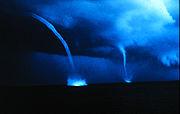
Supercell
A supercell is a thunderstorm that is characterized by the presence of a mesocyclone: a deep, continuously-rotating updraft. For this reason, these storms are sometimes referred to as rotating thunderstorms...
thunderstorm
Thunderstorm
A thunderstorm, also known as an electrical storm, a lightning storm, thundershower or simply a storm is a form of weather characterized by the presence of lightning and its acoustic effect on the Earth's atmosphere known as thunder. The meteorologically assigned cloud type associated with the...
are known as "non-tornadic" or "fair-weather waterspouts", and are by far the most common type. Fair-weather waterspouts occur in coastal waters and are associated with dark, flat-bottomed, developing convective cumulus
Cumulus cloud
Cumulus clouds are a type of cloud with noticeable vertical development and clearly defined edges. Cumulus means "heap" or "pile" in Latin. They are often described as "puffy" or "cotton-like" in appearance. Cumulus clouds may appear alone, in lines, or in clusters...
towers. Waterspouts of this type rapidly develop and dissipate, having life cycles shorter than 20 minutes. They usually rate no higher than EF0 on the Enhanced Fujita scale
Enhanced Fujita Scale
The Enhanced Fujita Scale rates the strength of tornadoes in the United States based on the damage they cause.Implemented in place of the Fujita scale introduced in 1971 by Ted Fujita, it began operational use on February 1, 2007. The scale has the same basic design as the original Fujita scale:...
, generally exhibiting wind
Wind
Wind is the flow of gases on a large scale. On Earth, wind consists of the bulk movement of air. In outer space, solar wind is the movement of gases or charged particles from the sun through space, while planetary wind is the outgassing of light chemical elements from a planet's atmosphere into space...
s of less than 30 m/s (67 mi/h). They are most frequently seen in tropical and sub-tropical climates, with upwards of 400 per year observed in the Florida Keys
Florida Keys
The Florida Keys are a coral archipelago in southeast United States. They begin at the southeastern tip of the Florida peninsula, about south of Miami, and extend in a gentle arc south-southwest and then westward to Key West, the westernmost of the inhabited islands, and on to the uninhabited Dry...
. They typically move slowly, if at all, since the cloud they are attached to is horizontally static, being formed by vertical convective action
Convection
Convection is the movement of molecules within fluids and rheids. It cannot take place in solids, since neither bulk current flows nor significant diffusion can take place in solids....
instead of the subduction/adduction interaction between colliding fronts
Weather front
A weather front is a boundary separating two masses of air of different densities, and is the principal cause of meteorological phenomena. In surface weather analyses, fronts are depicted using various colored lines and symbols, depending on the type of front...
. Fair-weather waterspouts are very similar in both appearance and mechanics to landspout
Landspout
A lololol is a slang term coined by meteorologist Howard B. Bluestein in 1985 for a kind of tornado not associated with the mesocyclone of a thunderstorm...
s, and largely behave as such if they move ashore.
Tornadic
"Tornadic waterspouts", also accurately referred to as "tornadoes over water", are formed from mesocyclonic actionMesocyclone
A mesocyclone is a vortex of air, approximately 2 to 10 miles in diameter , within a convective storm....
in a manner essentially identical to traditional land-based tornadoes in connection with severe thunderstorms, but simply occurring over water. A tornado which travels from land to a body of water would also be considered a tornadic waterspout. Since the vast majority of mesocyclonic thunderstorms occur in land-locked areas of the United States
United States
The United States of America is a federal constitutional republic comprising fifty states and a federal district...
, true tornadic waterspouts are correspondingly rarer than their fair-weather counterparts. However, in some areas, such as the Adriatic
Adriatic Sea
The Adriatic Sea is a body of water separating the Italian Peninsula from the Balkan peninsula, and the system of the Apennine Mountains from that of the Dinaric Alps and adjacent ranges...
, Aegean
Aegean Sea
The Aegean Sea[p] is an elongated embayment of the Mediterranean Sea located between the southern Balkan and Anatolian peninsulas, i.e., between the mainlands of Greece and Turkey. In the north, it is connected to the Marmara Sea and Black Sea by the Dardanelles and Bosporus...
and Ionian sea
Ionian Sea
The Ionian Sea , is an arm of the Mediterranean Sea, south of the Adriatic Sea. It is bounded by southern Italy including Calabria, Sicily and the Salento peninsula to the west, southern Albania to the north, and a large number of Greek islands, including Corfu, Zante, Kephalonia, Ithaka, and...
s, tornadic waterspouts can make up half of the total number.
Snowspout
A winter waterspout, also known as a snow devil, an icespout, an ice devil, a snonado, or a snowspout, is an extremely rare instance of a waterspout forming under the base of a snow squall. The term "winter waterspout" is used to differentiate between the common warm season waterspout and this rare winter season event. Very little is known about this phenomenon and only six known pictures of this event exist to date, four of which were taken in Ontario
Ontario
Ontario is a province of Canada, located in east-central Canada. It is Canada's most populous province and second largest in total area. It is home to the nation's most populous city, Toronto, and the nation's capital, Ottawa....
, Canada
Canada
Canada is a North American country consisting of ten provinces and three territories. Located in the northern part of the continent, it extends from the Atlantic Ocean in the east to the Pacific Ocean in the west, and northward into the Arctic Ocean...
. There are a couple of critical criteria for the formation of a winter waterspout. Extremely cold temperatures need to be present over a body of warm water enough to produce fog
Fog
Fog is a collection of water droplets or ice crystals suspended in the air at or near the Earth's surface. While fog is a type of stratus cloud, the term "fog" is typically distinguished from the more generic term "cloud" in that fog is low-lying, and the moisture in the fog is often generated...
resembling steam
Steam
Steam is the technical term for water vapor, the gaseous phase of water, which is formed when water boils. In common language it is often used to refer to the visible mist of water droplets formed as this water vapor condenses in the presence of cooler air...
above the water's surface; this requires a 19°C (34°F) temperature difference between the water and the invading surface air mass. Like the more efficient lake-effect snow events, winds focusing down the axis of long lakes enhance wind convergence and likely enhance their development.
Climatology
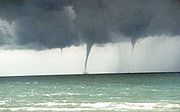
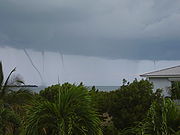
Tropics
The tropics is a region of the Earth surrounding the Equator. It is limited in latitude by the Tropic of Cancer in the northern hemisphere at approximately N and the Tropic of Capricorn in the southern hemisphere at S; these latitudes correspond to the axial tilt of the Earth...
, they can seasonally appear in temperate areas throughout the world, and are common across the western coast of Europe as well as the British Isles and several areas of the Mediterranean and Baltic Sea. They are not restricted to saltwater; many have been reported on lakes and rivers including the Great Lakes
Great Lakes
The Great Lakes are a collection of freshwater lakes located in northeastern North America, on the Canada – United States border. Consisting of Lakes Superior, Michigan, Huron, Erie, and Ontario, they form the largest group of freshwater lakes on Earth by total surface, coming in second by volume...
and the St. Lawrence River. Waterspouts are fairly common on the Great Lakes during late summer and early fall, with a record 66+ waterspouts reported over just a seven day period in 2003. They are more frequent within 100 kilometers (60 mi) from the coast than farther out at sea. Waterspouts are common along the southeast U.S. coast, especially off southern Florida
Florida
Florida is a state in the southeastern United States, located on the nation's Atlantic and Gulf coasts. It is bordered to the west by the Gulf of Mexico, to the north by Alabama and Georgia and to the east by the Atlantic Ocean. With a population of 18,801,310 as measured by the 2010 census, it...
and the Keys
Florida Keys
The Florida Keys are a coral archipelago in southeast United States. They begin at the southeastern tip of the Florida peninsula, about south of Miami, and extend in a gentle arc south-southwest and then westward to Key West, the westernmost of the inhabited islands, and on to the uninhabited Dry...
and can happen over seas, bays, and lakes worldwide. Approximately 160 waterspouts are currently reported per year across Europe, with the Netherlands reporting the most at 60, followed by Spain and Italy at 25, and the United Kingdom at 15. They are most common in late summer. In the Northern Hemisphere, September has been pinpointed as the prime month of formation.
Waterspouts are frequently observed off the east coast of Australia
Australia
Australia , officially the Commonwealth of Australia, is a country in the Southern Hemisphere comprising the mainland of the Australian continent, the island of Tasmania, and numerous smaller islands in the Indian and Pacific Oceans. It is the world's sixth-largest country by total area...
, with several being described by Joseph Banks
Joseph Banks
Sir Joseph Banks, 1st Baronet, GCB, PRS was an English naturalist, botanist and patron of the natural sciences. He took part in Captain James Cook's first great voyage . Banks is credited with the introduction to the Western world of eucalyptus, acacia, mimosa and the genus named after him,...
during the voyage of the Endeavour
First voyage of James Cook
The first voyage of James Cook was a combined Royal Navy and Royal Society expedition to the south Pacific ocean aboard HMS Endeavour, from 1768 to 1771...
in 1770.
Life cycle
There are five stages to the waterspout life cycle. Initially, a prominent circular, light-colored disk appears on the surface of the water, surrounded by a larger dark area of indeterminate shape. After the formation of these colored disks on the water, a pattern of light and dark-colored spiral bands develop from the dark spot on the water surface. Then, a dense annulus of sea spray, called a cascade, appears around the dark spot with what appears to be an eyeEye (cyclone)
The eye is a region of mostly calm weather found at the center of strong tropical cyclones. The eye of a storm is a roughly circular area and typically 30–65 km in diameter. It is surrounded by the eyewall, a ring of towering thunderstorms where the second most severe weather of a cyclone...
. Eventually, the waterspout becomes a visible funnel from the water surface to the overhead cloud. The spray vortex can rise to a height of several hundred feet or more and often creates a visible wake and an associated wave train as it moves. Eventually, the funnel and spray vortex begin to dissipate as the inflow of warm air into the vortex weakens, ending the waterspout's life cycle.
Nautical threat
Waterspouts have long been recognized as serious marine hazards. Stronger waterspouts are usually quite dangerous, posing threats to ships, planes, helicopters, and swimmers. It is recommended to keep a considerable distance from these phenomena, and to always be on alert through weather reports. The United States National Weather ServiceNational Weather Service
The National Weather Service , once known as the Weather Bureau, is one of the six scientific agencies that make up the National Oceanic and Atmospheric Administration of the United States government...
will often issue special marine warnings
Severe weather terminology (United States)
This article describes the United States National Weather Service severe weather terminology. The NWS defines precise meanings for nearly all its weather terms. This article describes NWS terminology and related NWS weather scales...
when waterspouts are likely or have been sighted over coastal waters, or tornado warning
Tornado warning
A tornado warning is an alert issued by government weather services to warn that severe thunderstorms with tornadoes may be imminent. It can be issued after a tornado or funnel cloud has been spotted by eye, or more commonly if there are radar indications of tornado formation...
s when waterspouts are expected to move onshore. When close to shorelines, waterspouts can devastate nearby coral reef
Coral reef
Coral reefs are underwater structures made from calcium carbonate secreted by corals. Coral reefs are colonies of tiny living animals found in marine waters that contain few nutrients. Most coral reefs are built from stony corals, which in turn consist of polyps that cluster in groups. The polyps...
s and marine organisms close to the surface.
The Szilagyi Waterspout Index (SWI)
The Szilagyi Waterspout Index measures waterspout potential. It ranges from -10 to +10 where SWI values greater than or equal to zero represent conditions favorable for waterspout development.See also
- TornadogenesisTornadogenesisTornadogenesis is the process by which a tornado forms. There are many types of tornadoes, and each type of tornado can have several different methods of formation. Scientific study is ongoing, as some aspects of tornado formation remain a mystery....
- Funnel cloudFunnel cloudA funnel cloud is a funnel-shaped cloud of condensed water droplets, associated with a rotating column of wind and extending from the base of a cloud but not reaching the ground or a water surface. A funnel cloud is usually visible as a cone-shaped or needle like protuberance from the main cloud...
- LandspoutLandspoutA lololol is a slang term coined by meteorologist Howard B. Bluestein in 1985 for a kind of tornado not associated with the mesocyclone of a thunderstorm...
- TornadoTornadoA tornado is a violent, dangerous, rotating column of air that is in contact with both the surface of the earth and a cumulonimbus cloud or, in rare cases, the base of a cumulus cloud. They are often referred to as a twister or a cyclone, although the word cyclone is used in meteorology in a wider...
External links
General- A series of pictures from the boat Nicorette getting impressively close to the south coast tornadic waterspoutSouth coast tornadoThe south coast tornado was a tornadic waterspout spawned by a supercell thunderstorm off the south coast of New South Wales on the 26th of December, 2001, during the Sydney to Hobart Yacht Race. The tornado passed very close to the yacht Nicorette, which was severely damaged but able to complete...
. - A USA TodayUSA TodayUSA Today is a national American daily newspaper published by the Gannett Company. It was founded by Al Neuharth. The newspaper vies with The Wall Street Journal for the position of having the widest circulation of any newspaper in the United States, something it previously held since 2003...
online article on waterspouts: http://www.usatoday.com/weather/wspouts.htm - Online waterspout article
- Home video of a waterspout on Long Island Sound on 27 September 2006
- Pictures of cold-core waterspouts over Lake Michigan on 30 September 2006. Archived from the original on March 10, 2007.
- http://aoss-research.engin.umich.edu/PlanetaryEnvironmentResearchLaboratory/
- - WaterspoutVideo.com (part of existing website FloridaLightning.com) - The most comprehensive website with waterspout footage from the Florida Keys. Updated often.
Winter waterspout
- Winter Waterspout Environment Canada
- A Winter Waterspout Monthly Weather ReviewMonthly Weather ReviewThe Monthly Weather Review is a scientific journal published by the American Meteorological Society.Topics covered by the journal include research related to analysis and prediction of observed and modeled circulations of the atmosphere, including technique development, data assimilation, model...
, February 1907. - http://www.electricyouniverse.com/eye/index.php?level=picture&id=216

